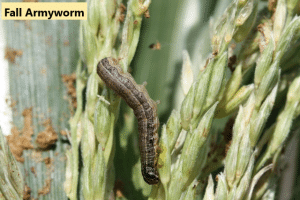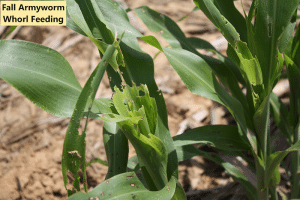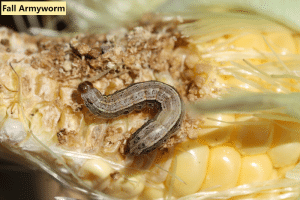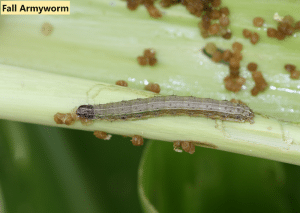Management options
| Insecticide (Trade Names) for FALL ARMYWORM | Lb Active Ingredient per Acre | Amount Formulation per Acre | Performance Rating |
|---|---|---|---|
| carbaryl (Sevin 80S) | 1 - 2 | 1.25 - 2.5 lb | 7 |
| carbaryl (Sevin XLR 4) | 1 - 2 | 32 - 64 oz | 7 |
| chlorantraniliprole (Vantacor 5 SC) | 0.047 - 0.067 | 1.2 - 1.71 oz | 9 |
| chlorantraniliprole, λ-cyhalothrin (Besiege) | See label | 6 - 10 oz | 9 |
| methomyl (Lannate LV 2.4) | 0.225 - 0.45 | 12 - 24 oz | 8 |
| methoxyfenozide (Intrepid 2F) | 1 - 1.25 | 8 - 10 oz | 8 |
| spinosad (Blackhawk 36% WDG) | 0.038 - 0.074 | 1.7 - 3.3 oz | 8 |
| β-cyfluthrin (Baythroid XL 1) * | 0.01 - 0.02 | 1.3 - 2.8 oz | 5 |
| γ-cyhalothrin (Declare 1.25) * | 0.01 - 0.015 | 1.02 - 1.54 oz | 5 |
| λ-cyhalothrin (Warrior II 2.08) * | 0.02 - 0.03 | 1.23 - 1.85 oz | 5 |
| Z-cypermethrin (Mustang Maxx 0.8) * | 0.01 - 0.025 | 1.76 - 4 oz | 5 |
* Pyrethroid insecticides may not provide adequate control of corn earworm or fall armyworm and are not recommended if infestations are well above the treatment threshold.
- Planting early, before mid-May, will generally help avoid some damage from fall armyworm and corn earworm.



